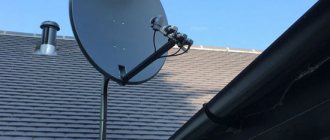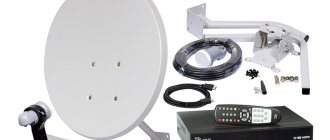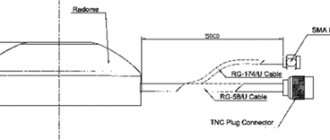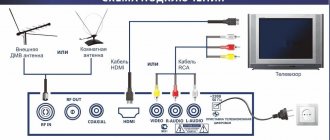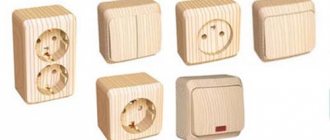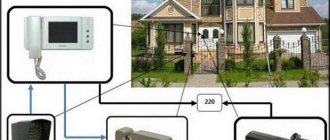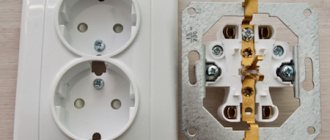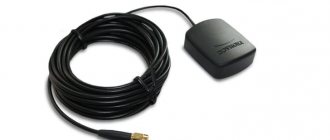In order to assemble and install a satellite television set at home on your own, without any practical knowledge, you need to follow a certain step-by-step sequence of work.
Let's look at the main points that you should pay special attention to when assembling the plate, wiring diagrams, and also focus on common mistakes that inexperienced installers make.
Installation materials
Let's start with the necessary materials. For assembly you will need:
- the plate itself
- multifeeds – fasteners for heads
Without them, if you have several heads, you will end up with a tree like this.
- mounting bracket - “leg”
- TV tuner or receiver
- RF coaxial cable with a characteristic impedance of at least 75 Ohms (RK 75 or Western analogue RG and SAT) + F connectors for it
- converters or heads - usually from one to 3 pieces (when assembling the so-called “Gorynych”)
- Diseqc switch – it switches the signal from one head to another when there are several of them
- multiswitch
You will need it if you want to simultaneously connect several TVs from one dish.
We determine the coordinates of the EutelsatW4 satellite using an online calculation program.
What is good about this program is that it also calculates the time of alignment of the azimuths of the Sun and the satellite. That is, it indicates the time when the Sun and the satellite are on the same line.
And so, you have already found the latitude and longitude of the settlement, I will show it using the example of my city of Astrakhan: this 46° 22′
north latitude and
48° 5′
east longitude.
And we will choose the satellite EutelsatW4
, by far the most popular due to the TricolorTV and NTV-PLUS packages.
We follow this link and an online calculation program window opens in front of us. I have already entered my data and received the result.
Multiswitch connection diagrams
The multiswitch itself must be selected depending on the number of cables and TVs in your home. The wiring diagrams for the most popular satellites are as follows:
- For the Amos 2/3 4.0w satellite, one SAT cable is enough. The connectors are connected to the ports as shown in the picture below:
- Astra 5.0E will require two cables. Connection ports:
- for Eutelsat 36.0E, where the NTV+ channels are located, two cables are also needed. Their connection diagram:
- for Eutelsat 36.0E, but with channels from Tricolor you can get by with one cable. It connects to the H, Hi input.
If you also have a regular television antenna, then the multiswitch must have a TerrTV input.
Connection diagram for the ABS-2A satellite via a multiswitch to receive a package of channels from MTS:
Keep in mind that when using a multiswitch, Daisik=Diseqc is no longer needed.
Algorithm
The setup procedure is simple, although it consists of a certain number of steps and requires consumables and some tools.
The equipment required for setting up TricolorTV usually includes three things - a dish, a receiver and an antenna. Also, you need to stock up on cables for all this and arm yourself with installation tools in order to install everything quickly and safely.
The general algorithm looks like this:
- You purchase a dish + receiver set from TricolorTV.
- Once at home, you secure the plate outside the windows of your apartment/house.
- Run the necessary cables from the dish to the receiver, and from the receiver to the TV.
- You adjust the signal level through the receiver software.
- Register as a TricolorTV user.
- Search for channels and leave the equipment to “calibrate”.
Satellite dish assembly
The assembly tool usually requires a pair of open-end wrenches for 10 and 13, plus a Phillips screwdriver. To mount it to the wall you will need a hammer drill and anchor bolts.
When you have decided on the package, first of all you need to correctly assemble the plate itself. There are several nuances here.
For example, when assembling the traverse, pay attention that the transverse bar, which is attached to the mirror of the plate itself, should be placed on top of it.
If you screw it on the other side, and this is physically possible, then:
- first, you will have poor hole alignment
- secondly, the opposite end of the traverse, where the heads cling, will go out of focus
As a result, it will initially be difficult to catch at least some signal. In addition, the mount that goes to the bracket, when setting up satellites above the horizon (relative to your geographic residence), must cling with the adjustable part down.
And for satellites located below the horizon - on the contrary, with the adjustable part up.
Since in this case, you will no longer need to raise, but lower the mirror.
Assembling the antenna
The antenna assembly process must be carried out in full accordance with its operating instructions. During this process, it is very important to handle the mirror carefully and as thoroughly as possible. Under no circumstances should you cause any mechanical damage to it that could change its geometry. First of all, this applies to mirrors that are made of aluminum. After assembling the antenna, it is imperative to check the tightness of all fasteners without exception.
The most important point of assembly is the installation of a satellite converter ( LNB - low-noise block downconverter). The correctness of its polarization directly affects the quality of the signal that the antenna will ultimately receive. In order to increase it, it is necessary to experimentally manually adjust the heads around their axis. The converter must eventually be secured in the most advantageous position.
Note! If it is not possible to adjust the converter after installing the antenna, this process must be completed in advance. Some additional information about assembly can be obtained from the seller of the fixture.
Before the installation process, experts recommend tying the antenna to safety cables. This way you can prevent it from accidentally falling from a height.
How to collect a multifeed
Assembling a multifeed also involves some special features. The collapsible kit initially comes with two unequal “ears”. One is more, the other is less.
The small one is put on a tube assembled with plastic.
The large one is attached to the central crossbeam. In this case, both ears can be positioned relative to each other in two different ways.
At the same level or in different planes. Most installers place them exactly in one plane.
Although if you do the opposite, this will make it easier to perform the very initial setup of the satellite dish and will save time when searching for additional side satellites.
The assembled heads will be at different levels, one higher, the other lower.
Actually, the satellites themselves fly across the horizon.
But this is of course true if your converters pick up three different satellites. When two heads are picking up the same satellite, for example Eutelsat 36E, but with different software packages, then place them in the same plane.
But mount the third head as described above. The spacing between the converters also depends on the diameter of the mirror. The smaller its size, the closer the heads will be located relative to each other.
After the bar is screwed on, try, at least by eye, to position the head so that the central axis of the plastic (where the two halves of the casting meet), and this very attachment to the traverse, are at an angle of 90 degrees. Further, everything will be regulated relative to this initial position.
The order in which multifeeds are interleaved also matters. The first and closest to the dish should be the multifeed whose satellite position is closer to your place of residence.
For example, if you live beyond 40 degrees, then Eutelsat 36.0E should appear on your dish first, then Hotbird 13E, and lastly Astra 5.0E. The same is true for other satellites.
After fixing the dish to the wall or roof, lay coaxial cables from this place to the tuner or switch.
Label each end with which head it comes from.
If you have a Dysec, there will be one output cable.
Equipment installation
This is the first stage and consists of two important parts - installing a dish with an antenna and wiring all cables from one point of the system to another.
Antenna and dish
The antenna and dish from TricolorTV comes with clear instructions on exactly how to install and mount them. There are additional rules, by following which you will ensure a reliable and high signal level almost immediately after installation:
- Be sure to follow the tilt prescribed for your region - this will determine whether the antenna will pick up the satellite signal or not.
- The plate must be located outdoors - it is not recommended to install it on loggias and glazed balconies, as the glass will create interference.
- There should be no additional obstacles between the antenna and the satellite in the form of other houses, green spaces or any building structures that could interrupt transmission.
- Be sure to make sure that the dish and antenna are not installed under a roof (slope) or rain gutter. This way you will avoid equipment damage during bad weather.
- The entire structure should “look” south.
- It is recommended to place the receiver as close to the antenna as possible. The permissible radius is one hundred meters, however, the closer, the stronger and better the signal will be.
When assembling the antenna and installing the dish, you must also follow several recommendations from TricolorTV:
- The equipment has a converter (see instructions). Under no circumstances should it be installed with the connector facing down, since this is one of the places where moisture easily gets in during rain. In this case, the signal will drop, and the equipment may even fail.
- The plate holder bracket should be mounted as firmly as possible, especially if you are installing the equipment on a windy side.
- First of all, do not fully tighten the nuts on the bracket when attaching the dish - you will still need to turn it to catch the signal, so do not fix it right away.
- The connectors on the cable should be screwed, having previously stripped it on both sides by approximately 1.5 cm.
Cable wiring
Running the cable after all the manipulations is not difficult. The diagram looks simple:
- One cable connects the antenna and receiver.
- The second cable connects the receiver and the TV (if you do not have Wi-Fi transmission).
An important point is to secure one side of the cable to the dish and antenna - it is best to do this with electrical tape so as not to damage the fastenings with anything else. Most often, it is because of a flimsily connected cable that users may lose the signal.
F connector connection
To connect coaxial cables, you need to strip them and put F-connectors on them. There are two ways to do this.
Method 1 – cut off only the outer sheath of the cable with a knife at a distance of 20-25mm. The screen must not be damaged.
Carefully bend all the wires onto the shell.
Now you need to remove the insulation from the central core. It should protrude from the screen by a maximum of 2mm.
After this, screw on the F connector.
Shorten the excess stock of the central core, leaving no more than 5mm from the plane of the connector.
Method 2 is easier. Take the utility knife again. Step back approximately 1cm from the edge of the cable and cut off all the insulation. Including external and internal, up to the central core.
Then, retreating 3mm, cut off only the outer braid.
Make sure that no lint or wires get between the braid and the central core.
There is no need to remove any more insulation or bend anything. Just insert and screw on the f connector from above.
Next, you lay out cables throughout the apartment in all the rooms where you have TVs. You sign them all too.
At the same time, it is much safer to run the cable directly into the device rather than connect it through a satellite TV outlet. This may be associated with either a loss of quality or a complete loss of signal.
The wiring diagram when using a multiswitch may look like this:
Settings Features
MTS stands out for the variety of devices offered for mass use. There may be:
- classic receiver with SMART card;
- CAM module for modern TVs, where you need to install an activated SIM card;
- version of the set-top box with interactive functionality.
Setting up MTS satellite TV with your own hands will depend on the above parameter. SMART SIM cards are required for the system to identify a specific subscriber. Without the correct installation of this chip, television operation will be unavailable. Follow the direction indicated on the instructions.
The further process will not cause difficulties, as it is performed using the “Settings Wizard”. Here you can find channels in automatic mode. Information about manual search can be found in a separate article.
Diseqc connection
If you only have a dashcam, connecting and configuring satellites is carried out in the following sequence.
Remember that any self-respecting store of satellite equipment and similar systems always sells tuners already programmed for certain channels and satellites. Otherwise, competitors will simply drive him out of the market.
At the same time, when purchasing, be sure to ask the seller to write you the Diseqc ports of the switch, since they were set by him during the settings. It is through these ports that you will have to make all cable connections.
When installing, you first connect the cables to the heads, and then run them to the dashik. Just on it, it is advisable to connect everything initially with the “factory” tuner settings.
If you have any satellite in the receiver configured to the first port, then accordingly it should not go to port No. 1. If it is on the second one, then port No. 2 is also used in the switch, etc.
All input ports are always signed. The central single connector is the output to the tuner itself.
Setting up a satellite dish for 3 satellites Amos, Astra, Sirius Hotbird
Installing satellite television from three satellites will allow you to watch many free Russian-language TV channels (more than 90) and a huge number of foreign ones (more than 2 thousand). Standard equipment:
- satellite antenna,
- three Ku-band converters;
- two plastic fastenings for side converters;
- antenna masts or brackets;
- DiSEqС (Disek) - converter switch;
- F-type connectors;
- coaxial cables 75 Ohm.
Astra
Transponders for satellites Astra, Amos, Hot Bird
Use a satellite tuner (receiver), for example Openbox X800. In the tuner menu, open the “Antenna installation” item and independently set the frequency for the Astra satellite, which will become central in our three-satellite connection:
- H – horizontal polarization;
- V – vertical polarization;
- position – 4.80 E;
- frequency – 11.766 GHz;
- symbol rate (S/R) – 27500;
- error correction (FEC) – ¾.
The antenna must be oriented towards the location of the satellite. When doing this, you must ensure that the antenna is pointed at the correct satellite. To check, you must enter the transponders shown in the table and turn on any channel. If no channels appear as a result of scanning, then the antenna is not configured correctly and the setup needs to be done again.
Amos
Setting up the Hotbird and Amos satellite is that you need to find the correct position of the converter relative to the center one. To do this, you must move it horizontally and vertically until you find an acceptable signal level.
- position – 13E;
- frequency – 10.815 GHz;
- symbol rate (S/R) – 30000.
Hotbird
Connect the cable to the converter, then open the tuner menu and set the following parameters:
- position – 4W;
- frequency – 11.139 GHz;
- symbol rate (S/R) – 27500.
Then connect DiSEqC to the appropriate converter and set the port numbers for each satellite in the tuner. For example, in our specific case:
- the first port is the Astra satellite;
- second port – Amos;
- third port – Hot Bird;
- the fourth port is free.
The so-called dragon is a satellite dish tuned to the three popular satellites Amos, Astra and Hotbird
Search for satellite and channels
Setting up and searching for a satellite can be done without fancy devices using the receiver itself.
True, you will have to drag the tuner itself + some small TV onto the roof.
Unless, of course, you install a motorcycle suspension.
This setup can also be done by two people. One person on the roof moves a plate, another uses a cell phone to control the house's TV signal.
If you are not satisfied with either one or the second option, you can buy a cheap portable device from the Chinese for setting up and analyzing the satellite signal - here or here.
Then setting up will not be difficult at all. By the way, it will be useful in the future if after a strong wind your signal deteriorates or you want to add a satellite over time, or maybe even change the heads. Configure satellites with MTS and Tricolor, instead of Amos, Astra, etc.
Start setting from the central head. Initially, place the plate with a slight rise towards the horizon. To find your bearings, look at your closest neighbors.
Nowadays, you will clearly no longer be a pioneer, and finding a couple of tuned cymbals will not be difficult. Sometimes there are so many of them that they interfere with each other.
As a last resort, you can use programs on smartphones - Satellite Director or SatFinder.
You install the program, launch it and start turning your smartphone in different directions in search of the desired satellite. The coordinates of most of them are already entered into the program and there is no need to search for anything.
An icon marked with a circle or cross will indicate the correct direction for the satellite dish. Refer to it.
Turn on the tuner, select a satellite from the central converter and look for at least some signal from this head. The search is performed by raising, lowering and rotating the antenna itself.
The signal quality is indicated as a percentage scale and is located at the bottom of the screen. You want to achieve the highest possible value.
To do this, very, very slowly begin to turn the plate in different directions. The mirror itself cannot be covered.
If there is no signal, or it is of very poor quality, the dish drops slightly. Then the process of turning around is repeated. As soon as a good quality signal is found in height, the dish is preliminarily fixed vertically.
After which, you can again turn it left and right to find the highest possible quality. There will never be 100%, just look for the highest possible figure - 68-75%, etc.
Having found the best position, finally clamp the rotating mechanism to the right and left. Just don’t fully tighten one bolt at a time, otherwise the plate will move to the side a couple of degrees. Tighten the nuts evenly, like on car wheels or an engine head.
When the corners are all set, it is necessary to again adjust the entire structure in height. Having loosened the fasteners, you begin to raise or lower it vertically, all the time monitoring the signal.
Remember that the maximum is always found using the downward method.
If you found it and went further, in the direction of decrease, raise the plate back a little higher and reach the point where the maximum signal is just beginning.
Why is this needed and what does it give? During long-term operation under the weight of snow, wind, and rain, the dish will still go down a little, worsening the signal.
You need to put it on a stretch, as it were. This will preserve the signal quality for a long time.
Keep in mind that the plate must initially be fixed level to the wall or roof.
If this is not observed, then having found the horizontal maximum of the signal, you will begin to look for the vertical maximum. And in the process of this, the horizontal position will go away. You will have to adjust the horizontal-vertical several times.
Next, proceed to the next stage of setup - scrolling around its axis of the central converter clockwise or counterclockwise. Here you can also achieve a signal improvement of several percent.
This way you have adjusted the plate itself and the central head. Let's move on to setting up side converters from other satellites.
Switch the tuner to the next satellite and call up its information line. Thanks to the multifeed, the converter of this satellite can also be rotated up and down, brought closer or further away from the dish.
Just like with the middle head, first look for the maximum on the vertical, and then move the side converter closer or farther towards the central one. At the end of the settings, rotate it around the axis.
When setting up satellites from the side converters, pay special attention to where you stand relative to the dish. On the side heads, the signal from the satellite arrives at the center of the mirror and, reflected like in a billiard, hits the converter.
So, in order not to block this signal with your body, you should be located on the nearest side of the tuning head, and not on the opposite side.
After searching and setting up a satellite from all three converters, the process can be considered complete. Hide and seal the cable from rain and precipitation, and securely secure the satellite cables with clamps to prevent them from being blown around by the wind.
Briefly about the main thing
A dish is part of a system designed to receive signals from a satellite. It works in conjunction with other modules, for which the system is assembled and debugged. After securing it to the bracket and connecting it to the other elements, the mirror is adjusted, for which it is set at the angle and azimuth corresponding to the given area and the selected satellite.
Question
Write in the comments what you think - is the adjustment of the position of the additional converter different compared to the central one?
Cable selection.
Take your cable choice seriously. In satellite television and the Internet via cable, in addition to the received signal, supply voltage is also supplied to the converter and special signals that are used to switch converter modes. Among the brands I can recommend CAVEL, SAT 703, 700, SAT 50, Bigsat.
It is not advisable to use a Chinese RG6, but if there is no other option, then try, when laying it, to reduce its length from the converter to the receiver as much as possible, since it has significant signal losses due to its low parameters and quality.
The bend radius of the cable should be 8-10 times the diameter of the cable itself, and try to find the shortest distance from the antenna to the receiver. The shorter the cable length, the better.
And so, let's summarize. You have chosen a satellite provider, purchased a set of equipment, decided on the antenna installation location, installed the bracket, assembled the antenna according to the instructions that came with the equipment, installed the converter and turned it to the value specified by the program. Now all that remains is to connect and configure the antenna. How to do this, read the continuation of the topic of setting up a satellite dish yourself in the second part. Good luck!
Online calculation program window:
Now let's look at everything in order.
In the top window, you find your locality and click on it with the mouse. Next, in the “satellite name” column, find Eutelsat W4 and click on it. All. The parameters we need have been found, I have outlined them with a large rectangle.
For those who did not find the name of their locality in the program window, do this:
in the “latitude” column, enter your latitude, as a decimal number, in the rectangle, and click on the circle with the mouse. In the “longitude” column we do the same, and below in the “satellite name” column, find EutelsatW4 and click on it in the same way. All parameters have been received.
